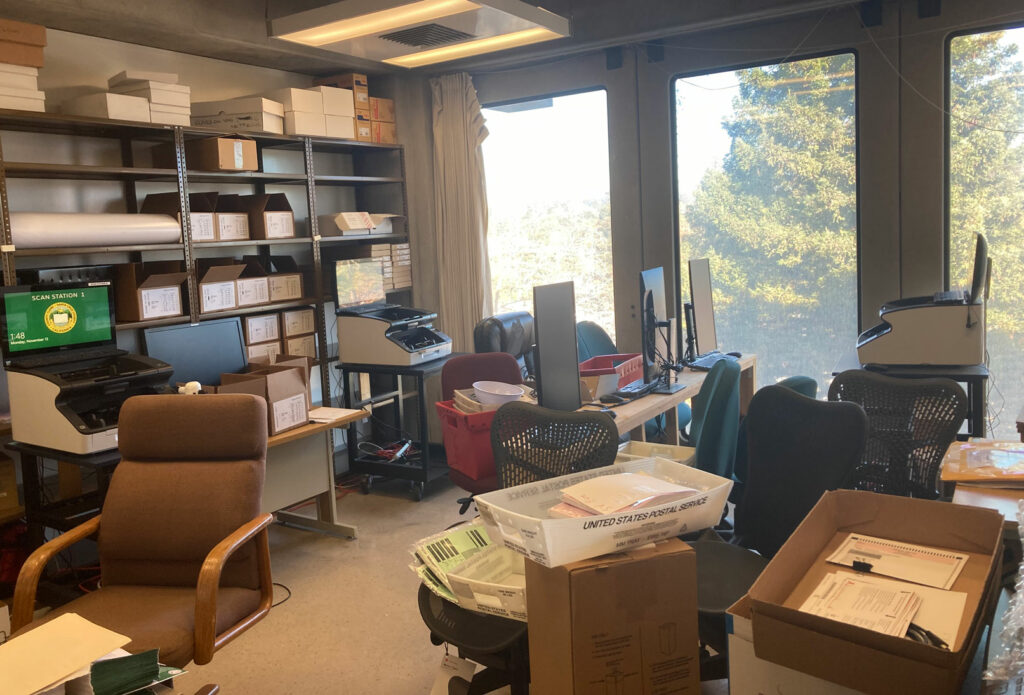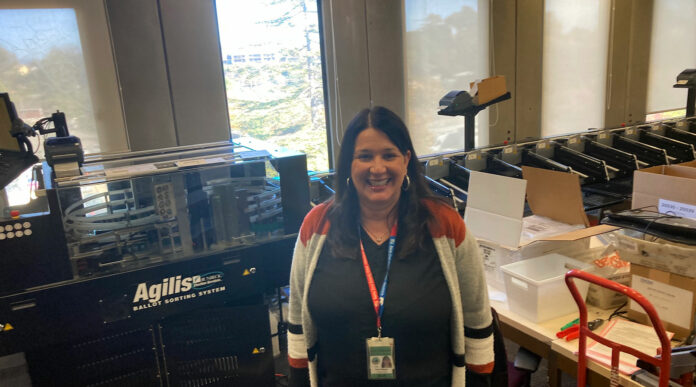The tax to raise money for public education sailed to success as nearly a third of Scotts Valley came out to cast a ballot, while a tax for a new fire hall hung in the balance.
A total of 3,246 people voted (72.57%) in the Oct. 24 election for Measure V, the Scotts Valley Unified School District parcel tax, compared to 1,227 (27.43%) who didn’t want the levy renewal, which included a slight increase.
Meanwhile, on Monday, an effort to secure funding for a new Scotts Valley Fire District station was teetering on the edge in unofficial results.
“Close elections are always a nail-biter,” said County Clerk Tricia Webber. “This is truly a good illustration of how every vote does count.”
Out of 4,806 total votes (representing 33.56% of the electorate), in the Nov. 7 election, 66.4% (3,187) were in support, while 33.6% (1,613) were against.
“Under the California Constitution, Health and Safety Code, and other related statutes, fire protection districts may issue general obligation bonds for very limited purposes,” the County Counsel’s office stated in an independent analysis. “The sale of such bonds must be approved by at least two-thirds (66 percent) [sic] of voters within the boundaries of that district.”
SVFD estimated the tax would be up to $27.50 per $100,000 of assessed property value per year.
The “Yes” camp had noted the current Erba Lane station isn’t fit to withstand a strong earthquake, isn’t up to building codes and isn’t in the most strategic location.
Fire officials wanted to embark on a construction project now before costs rise any further, or before the community has to face another natural or man-made disaster.
But some Scotts Valley residents with a fiscally-conservative streak weren’t too excited about the prospect of additional asks from government, as seen in basic hand-drawn signs demanding no new taxes be levied.
On the other hand, the prospect of not reinvesting in learning resources for the upper-middle class community’s children just didn’t sit right with the vast majority of residents who cast a vote.
Measure V boosters said the education tax was necessary to raise $1 million annually (an average of $168 per property) to pay more competitive waves, offer a variety of extracurricular programs and ensure students get the mental health support they need.
The current $108 annual parcel tax was approved with 70% support in November 2018 and was set to expire on June 30, next year.
The vote took place just as data emerged showing less than half of SVUSD high school students tested last year, in a statewide evaluation, had met standards in math, while a neighboring jurisdiction (Los Gatos-Saratoga Union School District) scored first in the State with almost three-quarters of its high schoolers succeeding in the subject.
So, what’s the difference in the two upscale Silicon Valley suburbs’ education systems? Well, for starters, teacher pay.
Earlier this year, the Los Gatos district was offering a minimum salary of $78,000, compared to $50,860 here (and that was even with a recent boost in pay for Scotts Valley teachers, in the most recent round of labor negotiations).
Superintendent Tanya Krause told the Press Banner she was thankful for the way Scotts Valley came together to support the funding initiative.
“I am extremely pleased and grateful for the community support in passing Measure V,” she said. “Continuing with the current parcel tax and adding five dollars a month will significantly assist the school district financially. District staff and students will benefit from this support. Thank you to the Campaign Committee and the volunteers who helped support this Measure. A special shout-out goes to campaign chairs Lindsay Rice and Cheryl Noble and board president Michael Shulman for their hard work. Also, thank you to Cheryl Ruyle, co-president of SVEA (Scotts Valley Education Association), the certificated union, who coordinated precinct walking. Our community support strengthens our district, and we are truly appreciative!”

Inside the recount
Overall, both votes went quite smoothly, according to the county clerk, who’s been in the elections department since 1997.
“Aside from the confusion of the fact that the two elections were 14 days apart, I think it went very well,” Webber said. “We didn’t hear any problems with the mail being delivered.”
Voter behavior trended quite predictable, with some people returning their ballots right away, and the majority leaving it until the last week—or last day, she reported.
But having two overlapping election timelines did result in staff having to educate people wondering why a couple ballots had appeared at their home over the course of just a few days.
“They’re looking at their mail going, ‘I got two ballots,’” Webber said. “We had people who felt that there was a problem. There were people who felt there was mismanagement of our resources at the county level.”
Webber explained it’s not really possible to have economies of scale with multiple elections. Each has its own printing and mailing costs, and employees focus their energy on one or the other, and make note of it.
“Our resources couldn’t be shared,” she said. “Our staff knows how to allocate their time.”
During every election, at least 1% of ballots are checked by hand for inconsistencies with the machines.
“We found no discrepancies,” Webber said.
Ballots that come in go through a Runbeck Agilis processor.
“This big machine is our sorter,” she said, giving the Press Banner a tour of the tranquil third-floor office space in the County building in Santa Cruz, Monday afternoon, that was the site of frenetic, but methodical, activity as John Hancocks were evaluated.
During the SVFD tax count, they found 15 envelopes with signature issues. These were placed into the “challenge phase,” where election workers sought to ensure no sketchy votes got added to the tally.
They found six ballots where neither option was selected—also known as undervotes.
“They came back as blank ballots,” Webber said. “It means that the voter chose, for whatever their reason, not to vote ‘Yes’ or ‘No,’ but they wanted to return the ballot.”
People who return an empty ballot don’t get to fill something in later. However, people who submitted envelopes with signature issues do get a chance to “cure” this discrepancy.
Webber plans to certify the results on Monday, Nov. 27, so signing problems have to be remedied by then.
“They’ve all been notified,” she said. “We mailed a letter, because there’s a specific form that people have to fill out inside.”
The space becomes a little dusty, as the machine’s razor slices open the mail—but only after the personal endorsements check-out.
Next, ballots moved over to the next room, where Dominion tabulators sprang into action.
Two of the machines were used for the school district election, and two others were employed for the fire district count.
During the fire district election, there were nine votes that were “damaged” and had to be “remade,” under the guidance of a remake board.
This included some that were soaked with rain, and one that was partially damaged.
“The voter ripped off the upper half,” Webber said.
One or two military or overseas ballots had arrived, also. Legally, these sorts of votes must be remade, by hand (and this falls within the nine “damaged” ballots).
Two people were tasked with reconstituting the votes and two different staffers reviewed this step in the process.
On Nov. 9, the nine “damaged” votes were added to the new total.
There was another wildcard, as well—a single person who registered to vote after the deadline.
“We have to input it into the system and get them registered, and then we have to do a search to make sure they haven’t already voted,” Webber explained. “We’re still in the process of doing the adjudication.”
In fact, she notes, that might not happen until the very last day.
“It could be that somebody cures their ballot at the last minute at the deadline and that makes a difference,” she said, recalling the time two Watsonville City Council candidates were separated by a single vote. “We don’t have a stake as to what passes or doesn’t pass, or who wins or doesn’t win.”
So far, the questioned ballots only represent about .33% of the total votes cast.
However, on Monday the Clerk’s Office was still dealing with a further variable: votes that are postmarked on or before election day can be counted, provided they arrive at the County building within seven calendar days of the election.
Webber was planning on calling the post office late Tuesday, just to check if any straggling votes had arrived in the nick of time.
“Those would be considered timely,” she said. “Where the results are right now, it will depend on those outstanding ballots that are out there.”
In any event, one thing’s for certain, said Webber: They’re going to be doing a full, manual recount. She already ordered it, days ago.









